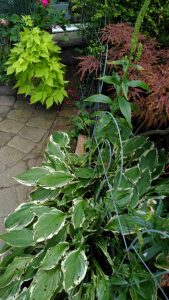
Something is eating my hosta leaves and has spread to a nearby obedience plant, as well as potato ivy and geranium leaves in a planter. What is it and what is the remedy? Thanks!
Thank you for contacting the TorontoMaster Gardeners with your inquiry.
The critter that is helping itself to your hostas leases and obedient plant may be slugs. Slugs live in damp places, under leaves and come out at night to feed. It may be challenging to find slug eggs, but if you clean up your yard, get rid of organic matter and wood and any other items that could provide shelter for the slugs, you’re off to a good start. The eggs may be on the surface of the soil and are often covered by debris or leaves. Unfortunately, as you won’t be able to find ALL the slug eggs, you may have a number of adult slugs invade your garden.
We receive numerous questions concerning the treatment and trapping of slugs. The following information is from a few of our archived posts:
” The best way to get rid of slugs is to hand-pick them in the early evening, about 2 hours after sunset, as the critters are more active at night. Go out with your flashlight, and examine the bases of pants, backs of leaves and between the rows of your vegetable garden. You can use a spoon to loosen the slugs from the plant, then put them in a pail of soapy water. Other methods, e.g., trapping them and spreading diatomaceous earth in areas they like to hide (this acts as a barrier as the particles are scratchy), may also be effective. See the Government of Canada’s article, Slugs and snails. The Weekend Gardener’s How to kill snails and slugs – the definitive guide, includes lots of helpful information – for example, they suggest luring the slugs to an area of your choosing, by putting upside-down orange or grapefruit rinds, or a flower pot, to attract the critters – they will crawl under them for shelter – -then BAM you can catch them. Check the “traps” each morning and if they yield results, replace with fresh rinds. After awhile, you’ll only have to check them once a week, as you will have gotten rid of a number of slugs.
There are also strategies you can use to make your garden less attractive to slugs. See Global news : How to prevent slugs and snails from destroying your garden (January 27 2014). For example:
- Choose plants that are resistant to slugs – e.g., see All About Slugs’ Slug and snail resistant plants. And ask your local nursery for plants that are less likely to be attacked by slugs. For example, while no host is slug-proof, there are some varieties that are more resilient to slugs (in particular the varieties with blue leaves that are thick and puckered).
- Water the garden less frequently and more deeply, and try not to water late in the day – morning is best (slugs are less active then)
- Slugs gather under mulch and other debris, and among weeds, so keep the garden area as tidy as possible.
And examine your plants often for signs of damage from slugs – look at the whole plant, from top to bottom, and both sides of leaves. If slugs have started to appear – take out your flashlight and go hunting! “
Also ” Beer traps are a good way to control them if the thought of hand picking leaves you cold. There are special slug traps sold at garden centres that you could consider. Another option is copper tape, which slugs and snails do not like to cross. Diatomaceous earth, coffee grounds, salt, wood ash, or crushed up eggshells sprinkled around the base of the plants are other options that are often mentioned as being effective. There are some commercial slug baits available. Avoid those containing metaldehyde. Varieties containing iron phosphate are less harmful. Also remember that birds dine on slugs, and will ingest the poison too.”
You may also find that earwigs are helping themselves to your potato vine leaves. Earwigs are approximately 2 cm long and posses a pair of forcep-like pincers. Like slugs, they feed at night on decaying organic matter as well as on the tender shoots, leaves, and blossoms of flowering plants and vegetables. Earwigs are also carnivorous,and are predators of insect larvae, slug eggs, aphids, and other garden pests. During the day, earwigs like to hide in cool, dark, moist places: under stones, in garden rubbish, inbetween the leaf sheath of plants.
The best time to begin control measures of earwigs is early spring, during dry, warm weather, when the earwigs are young. Cultivate the soil to disturb earwigs that lived through the winter and expose newly laid eggs to the dry surface where they are less likely to survive. Keep the lawn and garden free of excess debris and decaying organic matter to make it less attractive for earwigs. Don’t allow fallen leaves, weeds, and old wood to accumulate except where organic materials are stacked for proper composting.
To trap earwigs take advantage of the earwigs’ habit of hiding in small, dark places by setting out rolls of cardboard or lenghts of old garden hose in the evening, and in the morning, when the bugs are settling in for the day. Once captured, dump the earwigs into a bucket of warm soapy water.
Good Luck!

